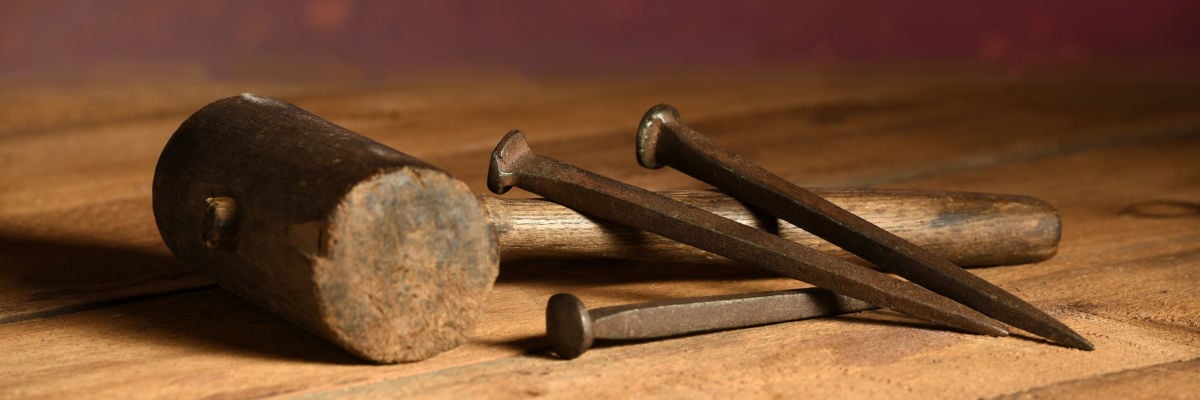
On Ash Wednesday 2004, the eagerly-awaited movie The Passion of the Christ hit the screen—and hit its viewers much harder. With ashen foreheads, Catholics across America cringed in their theater seats as they watched the portrayal of the intense whipping, beating, and stabbing of their Savior. Many in the audience openly wept.
As difficult as it was for the viewers to sit through these scenes, there is a reality that most audiences and reviewers missed: In comparison to the cinematic portrayal of the event, the actual crucifixion of Jesus was far worse.
Roman Crucifixion
Contemporary eyewitnesses, authors, and ancient and modern historians broadly confirm that crucifixion was a common practice before Constantine abolished it in the Roman Empire in the fourth century. But our focus here is on Roman crucifixion—for that is what Jesus suffered.
A study of crucifixion is such an analysis of violence and savagery that it is easy to lose sight of a central aspect of crucifixion: its intentional degradation. Under some Roman emperors, crucifixion was a common punishment for slaves. Cicero even refers to it as the servitutis extremum summumque supplicium (the highest and most extreme penalty for slaves). In his oration known as Against Verres, Cicero expresses that crucifixion should be used only on slaves and never against a citizen: “It is a crime to bind a Roman citizen; to scourge him is a wickedness; to put him to death is almost parricide. What shall I say of crucifying him? So guilty an action cannot by any possibility be adequately expressed by any name bad enough for it.”
It was standard procedure for Roman authorities to make crucifixions as public as possible. It was not enough for the Romans to simply crucify slaves and leave their carcasses to serve as food for the birds in the middle of nowhere. Instead, the Romans used crucifixion as a socio-political statement. Historian Barry Strauss explains, “Roman authorities also favored the most crowded roads for crucifixions, in order to impress the maximum number of people.”
As to the method of Roman crucifixion, the procedure generally occurred in three distinct stages: scourging at a pillar; the forced carrying of the cross; and nailing the victim to the cross, where he would eventually die. Each stage consisted of a tortured madness in which human misery was viewed as entertaining theater.
Stage One: Scourging
The process of scourging was given to those men who most enjoyed scourging others in the first place. In his book describing his experiences in a Nazi concentration camp, Man’s Search for Meaning, Viktor Frankl noted, “When the SS took a dislike to a person, there was always some special man in their ranks known to have a passion for, and to be highly specialized in, sadistic torture, to whom the unfortunate prisoner was sent.” The same basic process played out in the Roman scourging process.
The word “scourging” comes to us in English from the medieval French word escorgier, which means “to whip.” But the word fails to capture its innate ferocity. The victim’s wrists were tied to a post so that he could not defend himself against the weapons of torture, and then the beating commenced. In his book The Wars of the Jews, Jewish historian Flavius Josephus (A.D. 37-100) writes about the infliction of “stripes” before crucifixion, recounting that a woman was “torn to pieces with the stripes.” This was standard by design. One of the most popular devices used to scourge victims was the “scorpion”—a multi-thronged leather whip with affixed bone or metal. It was designed to hack into flesh and tear off the flesh to the bone.
Scourging was often conducted in such a way as to inflict the absolute maximum possible amount of pain without killing the victim; however, many victims of scourging died in the process. Nevertheless, the Romans often took it upon themselves to nail the scourged, dead bodies to crosses for public display. There were also instances in which the scourgers lost all interest in keeping their victims alive; with demonic ferocity, the soldiers simply beat them to death.
Stage Two: Carrying the Cross
For those who did survive the initial scourging—and the vast majority seem to have done so—the next step was forcing the victim to carry the wood of the cross to the designated place of death. For our purposes here, there is no need to go into great detail regarding this process other than pointing out the following: Carrying the wood of the cross to the place of death deliberately compounded the suffering already inflicted by the scourging. The shoulders, already ripped open by scourging, then had to endure carrying a massive piece of wood. This weight deeply compounded the pain of the open shoulder wound. The Roman philosopher Seneca, in observing the swelling of the crucified with “ugly weals on shoulders,” considered suicide as a preferable option to crucifixion.
Stage Three: Nailing to the Cross
After recounting the process of scourging and carrying the cross, it is striking that some ancient writers consider this the most violent stage of Roman crucifixion.[1] Though victims were sometimes tied to their crosses, they were typically nailed. In what seems to have been deemed a particular form of cruelty, some were crucified upside down. But they were not left to die alone. As Pierre Barbet notes, a Roman guard remained—in part—to ensure that the crucified man was not rescued by friends or family by the dead of night.
Some guards occupied their time in sadism. Some of the crucified continued to be beaten and jeered on the cross as they approached their deaths. It also occurred that visiting wives, children, and friends of the crucified had their throats slit as the crucified men watched helplessly from their crosses. (This might shed new light on the reluctance of the apostles to visit Jesus on the cross and provide an increased appreciation of Mary, Mary Magdalene, and John the apostle, who stood at the foot of the cross.)
One of the most significant variables was how long it took for the victim to die. Some died quickly; others survived for days. Typically, the Romans allowed, by design, birds and wild animals to eat the crucified carcasses for food; however, the Romans did sometimes allow families to claim the bodies.
The Unique Wounds of Jesus
Jesus bore some injuries in common with most others who endured Roman crucifixion, but he also had unique wounds. To understand subsequent cases of stigmata, we must first grasp Jesus’ suffering and wounds—which we might call the first stigmata.
To determine the extent and particular nature of Jesus’ injuries, it would be reasonable to first turn to Scripture. The difficulty, however, is that the scriptures are not very detailed. For instance, regarding the hyper-violent and bloodthirsty scourging of Jesus at the pillar, the Gospel of Matthew simply states, “Then he released for them Barabbas, and having scourged Jesus, delivered him to be crucified” (27:26). Mark’s Gospel simply states, “And they crucified him” (15:24). Luke’s Gospel gives more attention to the burial of Jesus than to the specifics of his injuries.
We may reasonably ask, Why is there such a lack of details? The answer given by Barbet is simple: “The Evangelists certainly had no need to be more explicit. For the Christians who had listened to the apostolic teaching, and who later on read the four Gospels, these two words, ‘scourging, crucifixion,’ were all too full of meaning; they had firsthand experience, and had seen scourgings and crucifixions; they knew what the words meant.”
Scourging and crucifixion continued for three centuries after Jesus’ death and resurrection. Thus, the early Christians were presented with physical reminders of Jesus’ torment until the time of Constantine, who abolished crucifixion in the Roman Empire. Subsequent ages increasingly lost sight—and understanding—of these terms.
Relying on Scripture alone does not provide us enough insight in the third millennium after Christ. Thus, we need to turn to more sources.
Regarding crucifixion generally, we have already referenced ancient historians and archaeological findings for details. Other places to look include the writings of the Church Fathers, approved private revelation, and the Shroud of Turin.
We can also touch upon the advantage of the advances in science and medicine. In some respects, from the perspective of modern medicine, we now know more about Jesus’ wounds and sufferings than ever before. The most logical way to proceed in an understanding of the first stigmata—the stigmata of Jesus—is to look at them from a chronological perspective, beginning with the events of Holy Thursday and culminating with the Resurrection.
Contemplating the Crucifixion is hard, but it deepens the faith of any Christian who takes on the task. God’s Wounds, Catholic Answers’ eye-opening new book by John Clark, provides the means to do this, and much more. Buy it here.
[1] Perhaps in an effort to defeat the integrity of the New Testament, some modern writers, historians, and even some anti-Catholic Christians have sought to illustrate that the Romans used a pole—rather than a cross—for crucifixion. But it was most certainly a cross. Confirmation of that fact is evidenced by Scripture, including each of the Gospels. As Woodrow Michael Kroll points out, “in the New Testament, the word “cross” (Greek: σταυρός; stauros) occurs twenty-seven times in twenty-seven verses.” That it was a cross is further evidenced by the early Church Fathers. Beyond that, the fact that the Romans routinely used crosses for crucifixion is evidenced by contemporary non-Christian historians such as Flavius Josephus.



